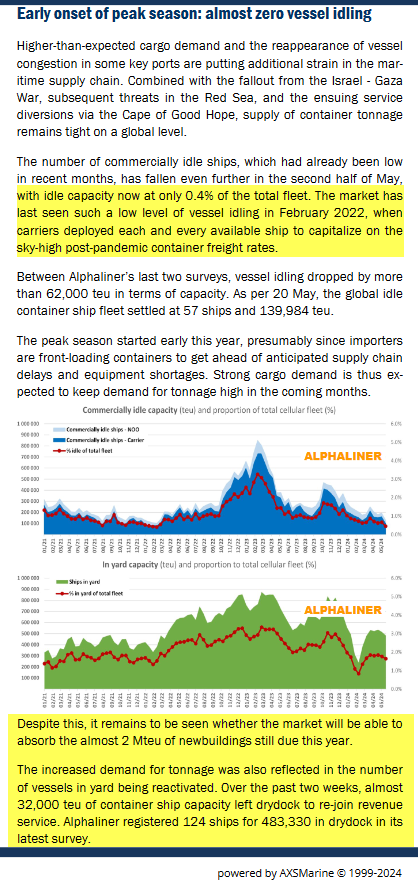[Market update]Supply/Demand – View on current demand in terms of supply (vessels) fully utilized
📄Headlines:
📈 Current Demand and Supply Utilization
- Fully utilized vessel capacity.
🚢 Early Peak Season Onset
- Almost zero vessel idling.
📦 Increased Cargo Demand and Congestion
- High cargo demand.
- Vessel congestion in key ports.
- Additional strain on the maritime supply chain.
- Effects of Israel-Gaza conflict and Red Sea threats.
- Service diversions via Cape of Good Hope.
🛳️ Low Commercially Idle Ships
- Idle capacity at only 0.4% of the total fleet.
- Lowest level since February 2022.
📉 Vessel Idling Reduction
- Dropped by more than 62,000 teu.
- As of May 20, the global idle container ship fleet is at 57 ships and 139,984 teu.
📦 Early Start of Peak Season
- Importers front-loading containers.
- Anticipated supply chain delays and equipment shortages.
- Strong cargo demand is expected to keep tonnage demand high.
🆕 Newbuildings Challenge
- The market needs to absorb almost 2 Mteu of new buildings due this year.
⚙️ Reactivation of Vessels
- Increased demand is reflected in reactivation.
- Almost 32,000 TEU of capacity was reactivated over the past two weeks.
- 124 ships for 483,330 teu in drydock in the latest survey.
Early onset of peak season: almost zero vessel idling
Higher-than-expected cargo demand and the reappearance of vessel congestion in some key ports are putting additional strain in the maritime supply chain. Combined with the fallout from the Israel – Gaza war, subsequent threats in the Red Sea, and the ensuing service diversions via the Cape of Good Hope, supply of container tonnage remains tight on a global level.
The number of commercially idle ships, which had already been low in recent months, has fallen even further in the second half of May, with idle capacity now at only 0.4% of the total fleet. The market has last seen such a low level of vessel idling in February 2022, when carriers deployed each and every available ship to capitalize on the sky-high post-pandemic container freight rates.
Between Alphaliner’s last two surveys, vessel idling dropped by more than 62,000 teu in terms of capacity. As per 20 May, the global idle container ship fleet settled at 57 ships and 139,984 teu.
The peak season started early this year, presumably since importers are front-loading containers to get ahead of anticipated supply chain delays and equipment shortages. Strong cargo demand is thus ex- pected to keep demand for tonnage high in the coming months.
Despite this, it remains to be seen whether the market will be able to absorb the almost 2 Mteu of newbuildings still due this year.
The increased demand for tonnage was also reflected in the number of vessels in yard being reactivated. Over the past two weeks, almost 32,000 teu of container ship capacity left drydock to re-join revenue service. Alphaliner registered 124 ships for 483,330 in drydock in its latest survey.

Quan điểm về nhu cầu hiện tại về mặt cung ứng (tàu) được sử dụng hoàn toàn
Khởi đầu sớm của mùa cao điểm: Gần như không có tàu nào bị nhàn rỗi
Nhu cầu hàng hóa cao hơn dự kiến và sự tái xuất hiện của tình trạng tắc nghẽn tàu tại một số cảng chính đang gây thêm áp lực lên chuỗi cung ứng hàng hải. Kết hợp với hậu quả của cuộc chiến Israel – Gaza, các mối đe dọa tiếp theo ở Biển Đỏ và sự chuyển hướng dịch vụ qua Mũi Hảo Vọng, nguồn cung container vẫn còn khan hiếm ở mức độ toàn cầu.
Số lượng tàu bị nhàn rỗi thương mại, vốn đã thấp trong những tháng gần đây, đã giảm thêm trong nửa cuối tháng 5, với công suất nhàn rỗi hiện tại chỉ là 0,4% tổng đội tàu. Thị trường đã từng chứng kiến mức nhàn rỗi tàu thấp như vậy vào tháng 2 năm 2022, khi các hãng vận tải triển khai mọi con tàu có sẵn để tận dụng mức cước phí container hậu đại dịch cao ngất ngưởng.
Giữa hai cuộc khảo sát gần đây của Alphaliner, tình trạng nhàn rỗi tàu giảm hơn 62,000 teu về công suất. Tính đến ngày 20 tháng 5, đội tàu container nhàn rỗi toàn cầu đạt 57 tàu và 139,984 teu.
Mùa cao điểm đã bắt đầu sớm năm nay, có lẽ vì các nhà nhập khẩu đang đẩy mạnh việc nhập hàng trước để tránh tình trạng trì hoãn chuỗi cung ứng và thiếu thiết bị dự kiến. Nhu cầu hàng hóa mạnh do đó dự kiến sẽ giữ nhu cầu cho tàu cao trong những tháng tới.
Mặc dù vậy, vẫn cần phải xem liệu thị trường có thể hấp thụ gần 2 Mteu tàu mới dự kiến ra mắt trong năm nay hay không.
Nhu cầu tăng đối với tàu cũng được phản ánh qua số lượng tàu tại xưởng đang được tái kích hoạt. Trong hai tuần qua, gần 32,000 teu công suất tàu container đã rời xưởng để tham gia lại dịch vụ có doanh thu. Alphaliner đã đăng ký 124 tàu cho 483,330 trong xưởng trong cuộc khảo sát mới nhất.



